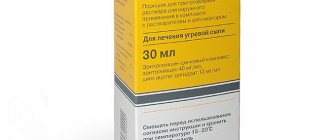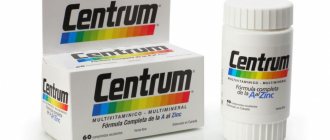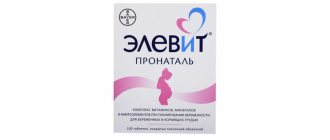Magnesium deficiency leads to muscle pain, stomach and intestinal cramps, general weakness, and rapid heartbeat. To overcome and prevent these consequences, taking Magne B6 tablets is indicated. This is an effective remedy that allows you to compensate for the lack of magnesium in a short time. It can be used by both adults and children over 6 years old.
Pharmacological properties of the drug Magne-B6
Pharmacodynamics. Under physiological conditions, magnesium is a cation that is mainly found inside cells. Magnesium reduces neuronal excitability and neuromuscular transmission and takes part in many enzymatic processes. Pyridoxine, a coenzyme factor, takes part in most metabolic processes. Pharmacokinetics. Magnesium is present in the body in an average concentration of 17 mmol/kg, 99% of it is found inside cells. Approximately 40–50% of the administered amount is subject to selective absorption in the mucous membrane of the small intestine. Almost 2/3 of intracellular magnesium is present in bone tissue, and 1/3 is in smooth or striated muscles and in red blood cells. Magnesium is primarily excreted through the kidneys. In the kidneys, 70% of magnesium undergoes glomerular filtration, after which 95–97% is reabsorbed in the renal tubules. Magnesium present in urine is, on average, 1/3 of the microelement received with food. In the body, pyridoxine undergoes oxidation to pyridoxal or is in the form of pyridoxamine. Due to subsequent phosphorylation, pyridoxal phosphate is formed. This form of pyridoxine is the active metabolite.
pharmachologic effect
The microelement in combination with vitamin B6 supports the normal functioning of muscles and the heart, regulates the conductivity of nerve fibers, and promotes protein synthesis. Without the participation of this duet, the delivery of nutrients and energy to cells, normal bile secretion, and intestinal motor activity are impossible.
Magne B6 helps to compensate for the deficiency of essential elements in the body, promotes the complete absorption of food, regulates cholesterol levels in the blood, accelerates metabolism, brain performance, supports resistance to stress, improves concentration, mood, memory, and prevents the development of anxiety, neuroses, and depressive states. Helps fight asthenia, procrastination, and obsessive mental states.
The active ingredients of the drug are absorbed into the blood through the gastric mucosa. Most of them from the intercellular space enter the bone tissue, the rest into the muscle fibers. Excretion of residual elements occurs in the urine.
Use of the drug Magne-B6
Adults are prescribed 6-8 tablets or the contents of 3-4 ampoules per day in 2-3 doses with meals. Children in tablet form are prescribed with meals at a rate of 10–30 mg/kg per day (0.4–1.2 mmol/kg per day), which for children over 6 years of age with a body weight of approximately 20 kg corresponds to 4– 6 tablets or in solution form for oral administration to children and infants weighing 10 kg, 1–4 ampoules per day in 2–3 divided doses. The contents of the ampoule are diluted in 1/2 cup of water. Magne B6 premium : the recommended dose for adults and children over 12 years of age is 3-4 tablets per day, divided into 2-3 doses. The recommended dose for children 6–12 years old (with a body weight of about 20 kg) is 2-4 tablets per day in 2-3 divided doses. The duration of treatment is 1 month. If after 1 month of treatment no improvement is observed, the drug is discontinued.
Composition and dosage forms
All types of the drug contain magnesium lactate and a synthetic analogue of natural pyridoxine. The product is available in the following forms:
- Tablets: oval, light, film-coated. Dosage of active elements in each: 470 mg of mineral and 5 mg of vitamin. The composition of the pills is supplemented with kaolin, sucrose, and other excipients. The shell contains carnauba wax. The drug is packaged in blisters of 10 or 15 pcs. Sold in packages of 30, 50 and 60 units.
- Magne B6 Forte. Increased dosage pills: 618 mg of mineral and 10 mg of active vitamin each.
- As a liquid in 10 ml glass ampoules: a brown translucent solution with a pleasant caramel odor. Each ampoule contains 936 mg of active microelement, sodium lactate and 10 mg of vitamin. Auxiliary components: saccharin, flavoring additives, water. Packages of the drug contain 10 ampoules.
All forms of the vitamin-mineral complex are intended for oral administration.
Special instructions for the use of the drug Magne-B6
In case of moderate renal failure, the drug should be used with caution to avoid the risk of developing hypermagnesemia. The ampoules contain sodium metabisulfite, which can lead to the development of allergic reactions, including anaphylactic ones, or increase their severity, especially in patients at risk. Magne B6 premium contains lactose. Due to the presence of lactose in the tablets, the drug is contraindicated in congenital galactosemia, glucose-galactose malabsorption syndrome or lactase deficiency. In case of moderate renal failure, the drug should be prescribed with caution due to the risk of hypermagnesemia. Serum magnesium levels: 12-17 mg/L (1-1.4 mEq/L or 0.5-0.7 mmol/L) – moderate magnesium deficiency; below 12 mg/L (1 mEq/L or 0.5 mmol/L) – severe magnesium deficiency. Magnesium deficiency can be: primary – due to a congenital abnormality of magnesium metabolism (chronic congenital hypomagnesemia); secondary – due to inadequate intake (severe malnutrition, alcoholism, parenteral nutrition only); due to impaired gastrointestinal absorption (chronic diarrhea, gastrointestinal fistula, hypoparathyroidism); due to loss at the renal level (tubular pathology, significant polyuria, diuretic abuse, chronic pyelonephritis, primary hyperaldosteronism, treatment with cisplatin). Use during pregnancy and breastfeeding. The drug can be used during pregnancy if necessary, although experimental data in animals is insufficient, limited clinical data show positive results from the use of the drug. Due to the fact that magnesium passes into breast milk, it is not recommended to use the drug during breastfeeding. Impact on the ability to drive a car and perform work that requires increased attention. Does not affect.
Application and dosage
Before starting the course, it is recommended to undergo a medical examination. In situations of increased risk (stress, high tension, unbalanced diet), in the absence of contraindications, a prophylactic course of drug use is allowed.
Magne B6 is approved for use from 1 year. It is more convenient to give it to small children in solution: 10–30 mg per 1 kg of body weight. For an adult, the recommended volume of liquid preparation is 3–4 ampoules per day.
Tablets are recommended from 6 years of age. Children under 12 are allowed 1–2 pieces. per day. Adults and adolescents: 4 to 8 tablets, divided into servings.
Magne B6 solution is diluted in ⅓–½ glass of water before use. The tablets are taken with liquid. The complex must be taken with food or immediately before meals.
The duration of the course depends on blood counts. A pronounced therapeutic effect is achieved already in the first weeks of administration. Then the efficiency increases. The drug is discontinued when the normal level of the mineral and vitamin in the body is reached.
Interactions of the drug Magne-B6
not recommended combinations : should not be prescribed simultaneously with preparations of phosphates or calcium salts (inhibit the absorption of magnesium in the digestive tract); combinations requiring caution when using : use oral tetracyclines with caution, since magnesium reduces the absorption of tetracyclines in the stomach and intestines. When used simultaneously with oral tetracyclines, the use of Magne-B6 should be delayed for at least 2 hours.
Indications
Regular use of the drug is indicated:
- with various nutritional disorders, poor diet;
- under mental, nervous stress, exhausting physical work, prolonged or severe stress;
- during active development of the body;
- in situations associated with increased consumption of magnesium and vitamin B: kidney disease, increased diuresis;
- impaired absorption of bioactive compounds from food: intestinal diseases, diarrhea;
- metabolic disorders in endocrine diseases, during menopause.
The need for additional amounts of magnesium and vitamin B6 is evidenced by high causeless fatigue, regular tachycardia, abdominal cramps, aching pain, tingling and involuntary muscle contractions, frequent anxiety, insomnia, irritability.
Overdose of Magne-B6, symptoms and treatment
Typically, oral magnesium overdose does not cause toxic reactions if renal function is normal. In renal failure, toxic effects caused by magnesium poisoning may occur. Symptoms of magnesium poisoning: decreased blood pressure, nausea, vomiting, central nervous system depression, slowed reflexes, ECG changes, respiratory depression, coma, cardiac arrest and respiratory paralysis, anuria. Treatment : rehydration, forced diuresis. In case of renal failure, hemodialysis or peritoneal dialysis is performed if necessary.
Side effects and interactions
Magne B6 has shown high effectiveness, is well absorbed, and rarely provokes negative reactions. In isolated cases, decreased appetite, nausea, and changes in blood pressure are possible.
In case of a critical overdose (tens of times or hundreds of times), depression of reflexes, dizziness, vomiting, tachycardia, and impaired coordination of movements are likely.
Magne B6 effectively replenishes the level of magnesium and pyridoxine in the body. During the period of taking it, there is no need to supplement it with other means of similar content. Otherwise, an overdose of elements is possible.
The complex should not be combined with calcium or phosphate supplements. Their simultaneous use impairs the absorption of magnesium in the body.
Magne B6 reduces the effect and slows down the absorption of tetracycline antibiotics. This should be taken into account when undergoing treatment. Antimicrobial agents and vitamin-mineral preparations must be taken at intervals of 3-4 hours.
Indications and contraindications
The drug is indicated for use in cases of diagnosed deficiency of magnesium and vitamin B6. Deficiency can manifest itself with the following symptoms:
- increased heart rate;
- general weakness and fatigue;
- muscle spasms, pain;
- tingling;
- sleep problems (not too pronounced);
- irritability;
- spasms of the stomach and/or intestines.
In some cases, medication is excluded:
- individual sensitivity to any component;
- severe renal failure;
- children up to 5 years old inclusive;
- fructose carbohydrate intolerance;
- malabsorption of galactose, glucose;
- combination with levodopa.
The tablets can be taken with caution in the presence of kidney failure (moderate stage). The medicine can be used during pregnancy, but should not be taken during breastfeeding.
special instructions
If an acute deficiency of magnesium is detected, therapy should begin with intravenous administration of the drug. During therapy, severe physical and mental stress and the intake of alcohol, as well as laxatives, should be avoided, since these factors provoke magnesium deficiency.
During long-term therapy in large quantities, sensory axonal neuropathy may develop. In this case, the following symptoms are observed:
- tremor of the limbs;
- problems with sensitivity;
- feeling of numbness.
Patients with diabetes mellitus should take this product with extreme caution, since it contains sucrose, among other compounds. The components of the drug do not reduce the speed of psychomotor reactions, so the tablets can be taken while driving a car.
"Magne B6": composition, description
The drug contains 2 active components - magnesium itself and pyridoxine, i.e. vitamin B6 (also called pyridoxal or pyridoxamine). It is produced in the form of tablets, which also contain additional components, for example, acacia gum, sucrose, magnesium in the form of stearate and others. Another form is a solution, which, like tablets, is taken orally
The product should be stored in a dry place at temperatures up to 25 degrees Celsius. It is necessary to exclude access to direct sunlight and also keep it away from children. The shelf life is 2 years from the date of production, subject to storage rules.





